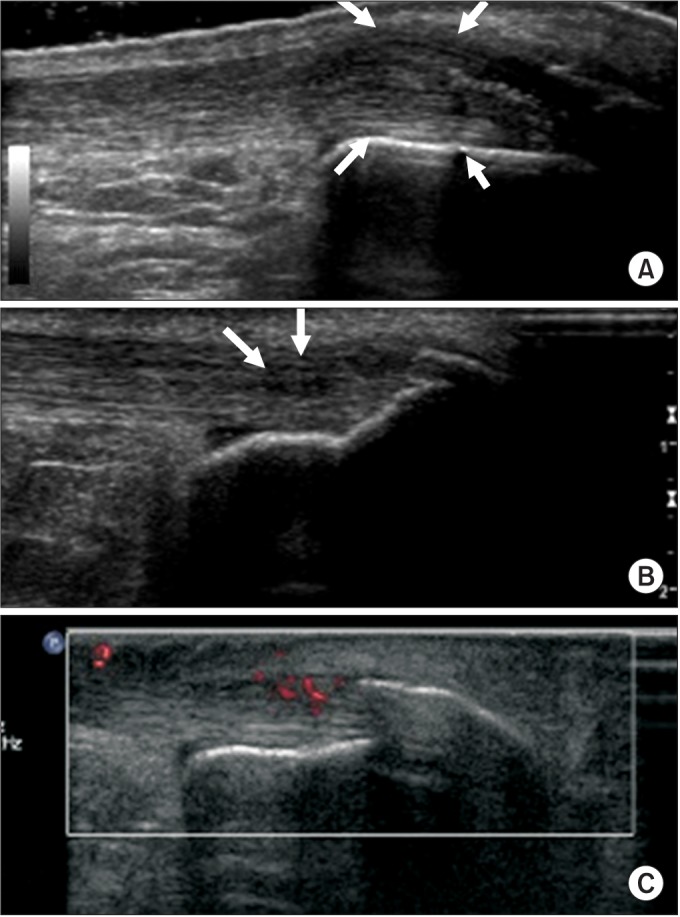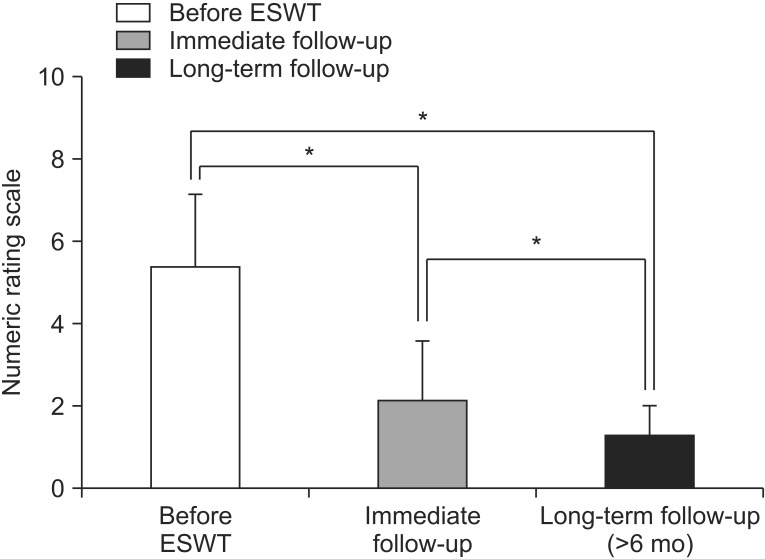Ann Rehabil Med.
2017 Feb;41(1):42-50. 10.5535/arm.2017.41.1.42.
Long-Term Outcome and Factors Affecting Prognosis of Extracorporeal Shockwave Therapy for Chronic Refractory Achilles Tendinopathy
- Affiliations
-
- 1Department of Physical and Rehabilitation Medicine, Kangbuk Samsung Hospital, Sungkyunkwan University School of Medicine, Seoul, Korea. yongtaek1.lee@samsung.com
- 2Department of Physical Medicine and Rehabilitation, Dongtan Sacred Heart Hospital, Hallym University College of Medicine, Hwaseong, Korea.
- 3Department of Physical and Rehabilitation Medicine, Samsung Changwon Hospital, Sungkyunkwan University School of Medicine, Changwon, Korea.
- KMID: 2383676
- DOI: http://doi.org/10.5535/arm.2017.41.1.42
Abstract
OBJECTIVE
To investigate the factors affecting prognosis of extracorporeal shockwave therapy (ESWT) for chronic refractory Achilles tendinopathy (AT).
METHODS
Thirty-six patients (48 consecutive feet) with chronic AT (>6 months) and who underwent ESWT for "˜poor' or "˜fair' grade in Roles-Maudsley Score (RMS) after unsuccessful conservative treatment were included in the present study. A maximum of 12 sessions of ESWT were conducted until treatment success: RMS reached "˜good' or "˜excellent'. Termination of ESWT for no response, or "˜poor' or "˜fair' grade was regarded as treatment failure. Immediate outcome, long-term outcome (telephone interview after mean 26 months), and factors affecting treatment success were analyzed.
RESULTS
Numeric Rating Scale was significantly decreased at immediate and long-term follow-up. Success rate was 71.1% and 90.3%, respectively. Univariate logistic regression identified that immediate treatment success was associated with retrocalcaneal enthesophyte on X-ray (odds ratio [OR], 0.06; 95% confidence interval [CI], 0.01-0.28), pretreatment abnormal ultrasonography echogenicity within Achilles tendon (OR, 18.89; 95% CI, 2.08-171.96), mean duration of "˜post-treatment soreness' (OR, 0.55; 95% CI, 0.33-0.94), and duration of "˜post-treatment soreness after first ESWT' (OR, 0.06; 95% CI, 0.01-0.34). The duration of "˜post-treatment soreness after first ESWT' was found to be the only factor associated with long-term success (OR, 0.32; 95% CI, 0.10-0.99).
CONCLUSION
ESWT appears to be effective in achieving long-term success in chronic refractory AT. Immediate success was associated with absence of retrocalcaneal enthesophyte on X-ray, presence of pretreatment abnormal ultrasonography echogenicity, shorter mean duration of "˜post-treatment soreness', and shorter duration of "˜post-treatment soreness after first ESWT'. The shorter duration of "˜post-treatment soreness after first ESWT' was identified as the only positive prognostic parameter in achieving long-term success.
MeSH Terms
Figure
Reference
-
1. Lake JE, Ishikawa SN. Conservative treatment of Achilles tendinopathy: emerging techniques. Foot Ankle Clin. 2009; 14:663–674. PMID: 19857840.
Article2. Gerdesmeyer L, Mittermayr R, Fuerst M, Al Muderis M, Thiele R, Saxena A, et al. Current evidence of extracorporeal shock wave therapy in chronic Achilles tendinopathy. Int J Surg. 2015; 24(Pt B):154–159. PMID: 26327530.
Article3. Alfredson H, Lorentzon R. Chronic Achilles tendinosis: recommendations for treatment and prevention. Sports Med. 2000; 29:135–146. PMID: 10701715.4. Furia JP. High-energy extracorporeal shock wave therapy as a treatment for insertional Achilles tendinopathy. Am J Sports Med. 2006; 34:733–740. PMID: 16627628.
Article5. Den Hartog BD. Insertional Achilles tendinosis: pathogenesis and treatment. Foot Ankle Clin. 2009; 14:639–650. PMID: 19857838.
Article6. Almekinders LC. Tendinitis and other chronic tendinopathies. J Am Acad Orthop Surg. 1998; 6:157–164. PMID: 9682077.
Article7. Lakshmanan P, O'Doherty DP. Chronic Achilles tendinopathy: treatment with extracorporeal shock waves. Foot Ankle Surg. 2004; 10:125–130.
Article8. Taylor J, Dunkerley S, Silver D, Redfern A, Talbot N, Sharpe I, et al. Extracorporeal shockwave therapy (ESWT) for refractory Achilles tendinopathy: a prospective audit with 2-year follow up. Foot (Edinb). 2016; 26:23–29. PMID: 26802946.
Article9. Rompe JD, Nafe B, Furia JP, Maffulli N. Eccentric loading, shock-wave treatment, or a wait-and-see policy for tendinopathy of the main body of tendo Achillis: a randomized controlled trial. Am J Sports Med. 2007; 35:374–383. PMID: 17244902.10. Mani-Babu S, Morrissey D, Waugh C, Screen H, Barton C. The effectiveness of extracorporeal shock wave therapy in lower limb tendinopathy: a systematic review. Am J Sports Med. 2015; 43:752–761. PMID: 24817008.11. Al-Abbad H, Simon JV. The effectiveness of extracorporeal shock wave therapy on chronic achilles tendinopathy: a systematic review. Foot Ankle Int. 2013; 34:33–41. PMID: 23386759.12. Bakkegaard M, Johannsen FE, Hojgaard B, Langberg H. Ultrasonography as a prognostic and objective parameter in Achilles tendinopathy: a prospective observational study. Eur J Radiol. 2015; 84:458–462. PMID: 25577603.
Article13. Van Holsbeeck M, Introcaso JH. Musculoskeletal ultrasound. St. Louis: Mosby;1991.14. Richards PJ, Dheer AK, McCall IM. Achilles tendon (TA) size and power Doppler ultrasound (PD) changes compared to MRI: a preliminary observational study. Clin Radiol. 2001; 56:843–850. PMID: 11895302.
Article15. Kainberger FM, Engel A, Barton P, Huebsch P, Neuhold A, Salomonowitz E. Injury of the Achilles tendon: diagnosis with sonography. AJR Am J Roentgenol. 1990; 155:1031–1036. PMID: 2120931.
Article16. Kallinen M, Suominen H. Ultrasonographic measurements of the Achilles tendon in elderly athletes and sedentary men. Acta Radiol. 1994; 35:560–563. PMID: 7946678.
Article17. Khan KM, Forster BB, Robinson J, Cheong Y, Louis L, Maclean L, et al. Are ultrasound and magnetic resonance imaging of value in assessment of Achilles tendon disorders? A two year prospective study. Br J Sports Med. 2003; 37:149–153. PMID: 12663358.
Article18. Koivunen-Niemela T, Parkkola K. Anatomy of the Achilles tendon (tendo calcaneus) with respect to tendon thickness measurements. Surg Radiol Anat. 1995; 17:263–268. PMID: 7502192.
Article19. Soila K, Karjalainen PT, Aronen HJ, Pihlajamaki HK, Tirman PJ. High-resolution MR imaging of the asymptomatic Achilles tendon: new observations. AJR Am J Roentgenol. 1999; 173:323–328. PMID: 10430128.
Article20. Benjamin M, Ralphs JR. The cell and developmental biology of tendons and ligaments. Int Rev Cytol. 2000; 196:85–130. PMID: 10730214.
Article21. Benjamin M, Rufai A, Ralphs JR. The mechanism of formation of bony spurs (enthesophytes) in the achilles tendon. Arthritis Rheum. 2000; 43:576–583. PMID: 10728751.
Article22. Kannus P, Jozsa L, Kvist M, Jarvinen TL, Maunu VM, Hurme T, et al. Expression of osteocalcin in the patella of experimentally immobilized and remobilized rats. J Bone Miner Res. 1996; 11:79–87. PMID: 8770700.
Article23. Tyrdal S, Finnanger AM. Osseous manifestations of ‘handball goalie's elbow’. Scand J Med Sci Sports. 1999; 9:92–97. PMID: 10220843.
Article24. Girolomoni G, Gisondi P. Psoriasis and systemic inflammation: underdiagnosed enthesopathy. J Eur Acad Dermatol Venereol. 2009; 23(Suppl 1):3–8. PMID: 19686379.
Article25. Feydy A, Lavie-Brion MC, Gossec L, Lavie F, Guerini H, Nguyen C, et al. Comparative study of MRI and power Doppler ultrasonography of the heel in patients with spondyloarthritis with and without heel pain and in controls. Ann Rheum Dis. 2012; 71:498–503. PMID: 21949008.
Article26. Aydin SZ, Can M, Alibaz-Oner F, Keser G, Kurum E, Inal V, et al. A relationship between spinal new bone formation in ankylosing spondylitis and the sonographically determined Achilles tendon enthesophytes. Rheumatol Int. 2016; 36:397–404. PMID: 26442943.
Article27. Genc H, Cakit BD, Tuncbilek I, Erdem HR. Ultrasonographic evaluation of tendons and enthesal sites in rheumatoid arthritis: comparison with ankylosing spondylitis and healthy subjects. Clin Rheumatol. 2005; 24:272–277. PMID: 15940560.
Article28. Chuckpaiwong B, Berkson EM, Theodore GH. Extracorporeal shock wave for chronic proximal plantar fasciitis: 225 patients with results and outcome predictors. J Foot Ankle Surg. 2009; 48:148–155. PMID: 19232966.
Article29. Maki M, Ikoma K, Imai K, Kido M, Hara Y, Arai Y, et al. Correlation between the outcome of extracorporeal shockwave therapy and pretreatment MRI findings for chronic plantar fasciitis. Mod Rheumatol. 2015; 25:427–430. PMID: 25401230.
Article30. Ohberg L, Alfredson H. Effects on neovascularisation behind the good results with eccentric training in chronic mid-portion Achilles tendinosis? Knee Surg Sports Traumatol Arthrosc. 2004; 12:465–470. PMID: 15060761.
Article31. Ohberg L, Lorentzon R, Alfredson H. Eccentric training in patients with chronic Achilles tendinosis: normalised tendon structure and decreased thickness at follow up. Br J Sports Med. 2004; 38:8–11. discussion 11. PMID: 14751936.32. Kulig K, Oki KC, Chang YJ, Bashford GR. Achilles and patellar tendon morphology in dancers with and without tendon pain. Med Probl Perform Art. 2014; 29:221–228. PMID: 25433259.
Article33. Haake M, Boddeker IR, Decker T, Buch M, Vogel M, Labek G, et al. Side-effects of extracorporeal shock wave therapy (ESWT) in the treatment of tennis elbow. Arch Orthop Trauma Surg. 2002; 122:222–228. PMID: 12029512.34. Peters J, Luboldt W, Schwarz W, Jacobi V, Herzog C, Vogl TJ. Extracorporeal shock wave therapy in calcific tendinitis of the shoulder. Skeletal Radiol. 2004; 33:712–718. PMID: 15480643.
Article35. Rompe JD, Kirkpatrick CJ, Kullmer K, Schwitalle M, Krischek O. Dose-related effects of shock waves on rabbit tendo Achillis: a sonographic and histological study. J Bone Joint Surg Br. 1998; 80:546–552. PMID: 9619954.36. Rompe JD, Furia J, Maffulli N. Eccentric loading compared with shock wave treatment for chronic insertional Achilles tendinopathy: a randomized, controlled trial. J Bone Joint Surg Am. 2008; 90:52–61.37. Furia JP. High-energy extracorporeal shock wave therapy as a treatment for chronic noninsertional Achilles tendinopathy. Am J Sports Med. 2008; 36:502–508. PMID: 18006678.
Article38. Rasmussen S, Christensen M, Mathiesen I, Simonson O. Shockwave therapy for chronic Achilles tendinopathy: a double-blind, randomized clinical trial of efficacy. Acta Orthop. 2008; 79:249–256. PMID: 18484252.
Article39. Sobhani S, Dekker R, Postema K, Dijkstra PU. Epidemiology of ankle and foot overuse injuries in sports: a systematic review. Scand J Med Sci Sports. 2013; 23:669–686. PMID: 22846101.
Article40. Filardo G, Kon E, Di Matteo B, Di Martino A, Tesei G, Pelotti P, et al. Platelet-rich plasma injections for the treatment of refractory Achilles tendinopathy: results at 4 years. Blood Transfus. 2014; 12:533–540. PMID: 24960641.
- Full Text Links
- Actions
-
Cited
- CITED
-
- Close
- Share
- Similar articles
-
- Nonoperative Treatment of Achilles Tendinopathy
- Focused Extracorporeal Shockwave Therapy for Postsurgical Achilles Tendon Tightness: A Case Report
- Extracorporeal Shock Wave Therapy in Musculoskeletal Disorders
- Achilles Tendinosis: Treatment Options
- Regenerative Medicine in the Treatment of Sports Injuries: Prolotherapy and Extracorporeal Shock Wave Therapy



